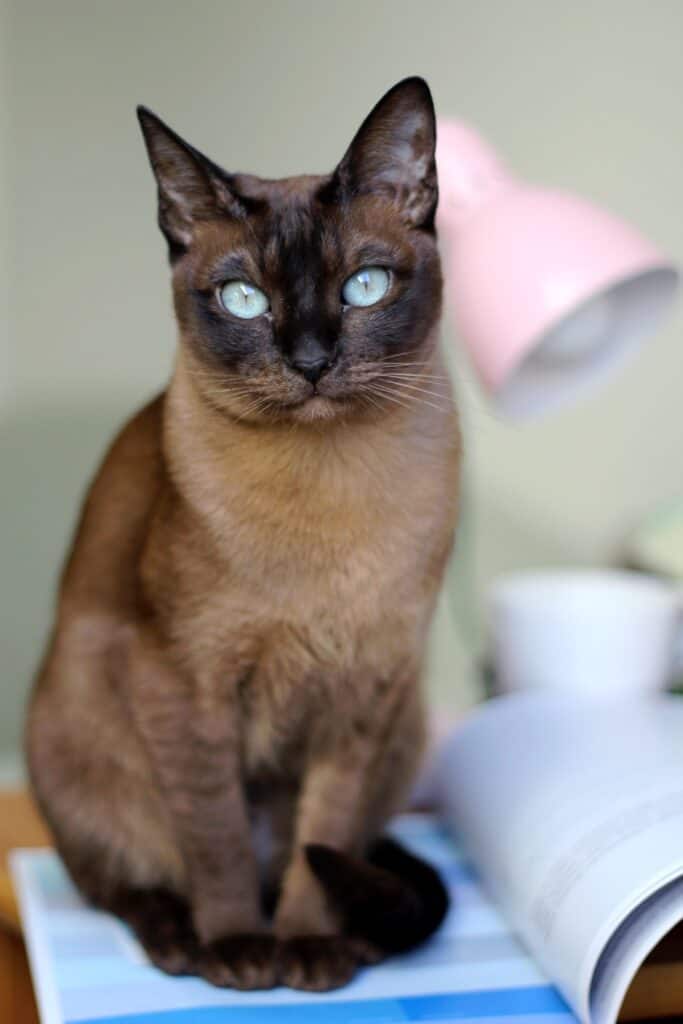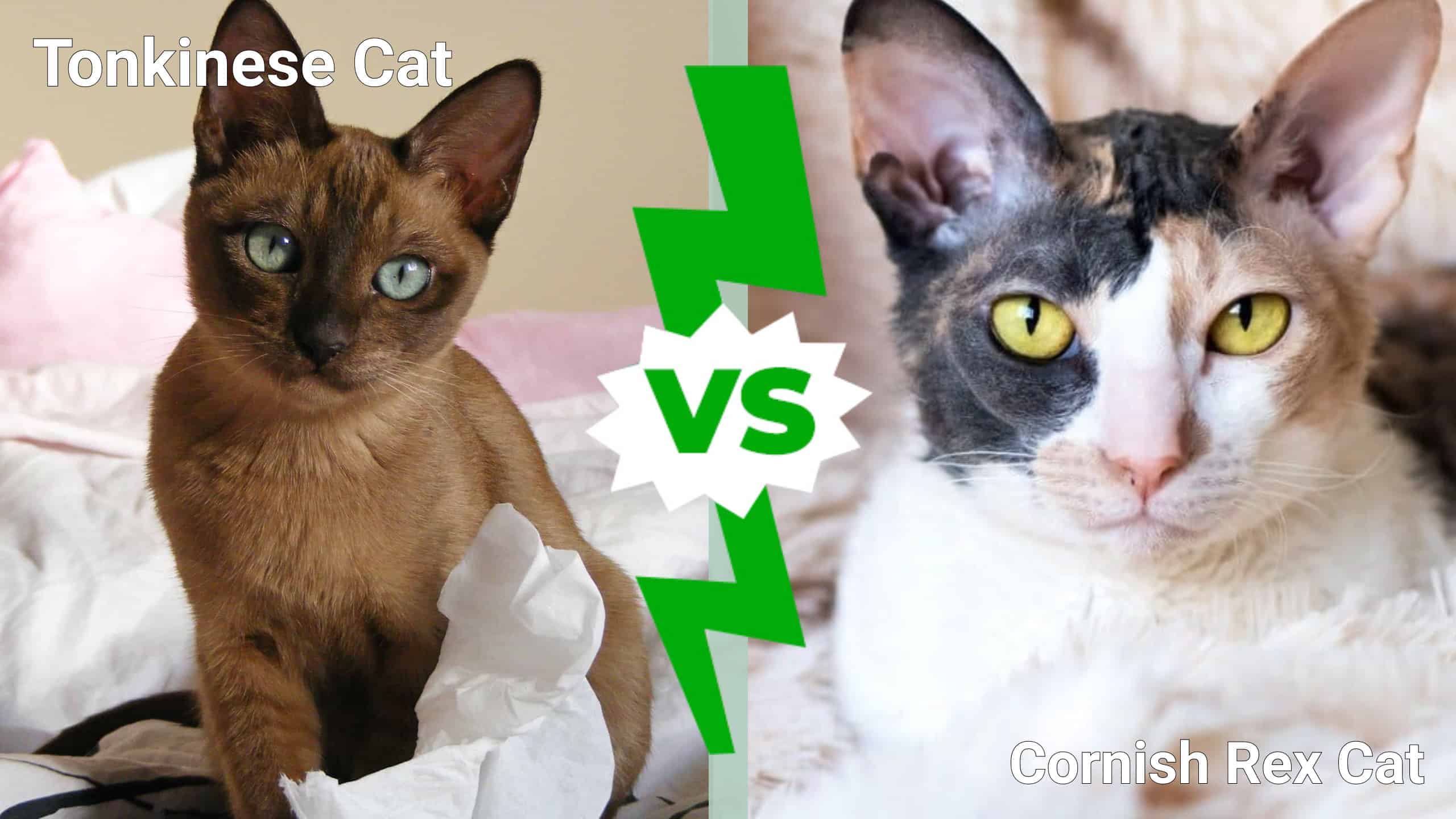While one requires minimal grooming, the other needs a little extra tender, loving care. Both have playful, sociable natures but one is a bit more curious than the other, getting mischievous when you turn your back. They’re both highly intelligent, however, and make wonderful feline companions. Discover the key differences between Tonkinese vs. Cornish Rex cats!
Tonkinese vs. Cornish Rex Cat: Key Differences Explained
| Tonkinese Cat | Cornish Rex Cat | |
|---|---|---|
| Appearance | Muscular with a natural cowlick on its chest May be full-color, mink, or pointed Looks like a cross between Burmese and Siamese cats (only a bit darker) | Narrow head with large ears Large eyes compared to head size Slender lengthy legs and wavy coats May be a range of solid colors (a few rare colors are possible) |
| Temperament | Intelligent, active, and mischievous if not entertained Loves being the center of attention Enjoys other people and pets | Intelligent, sociable, playful, and bold Affectionate and bonds with humans |
| Lifespan | 12 to 16 years old | 15 – 20 years old |
| Size and Weight | Medium size; eight to 12 pounds | Small to medium size; five to 10 pounds |
| Growth Cycle | Completely grown at about 24 months | Completely grown at about 12 months |
| Grooming Requirements | Minimal grooming required Dense coat Silky feel Requires regular dental care | Body oil buildup requires ear and paw cleaning Requires regular nail clipping Regular brushing to prevent matting |
Tonkinese vs. Cornish Rex Cat: Appearance
Tonkinese cats have a much more muscular appearance when compared to Cornish Rex cats. Although Cornish Rex cats may appear quite large, much of their height is due to their slender, long legs. Tonkinese cats are often mistaken for Burmese and Siamese cats, but Tonkinese cats are a little bit darker and have distinct areas on their face, ears, paws, and tails.
Their coats may be full color and their eyes may be green or blue (or sometimes a combination of both these colors). Cornish Rex cats have narrow faces and large ears that give them a unique appearance. Since their faces are so narrow, their eyes appear extra-large. Though some rare colors may occur in Cornish Rex cats, a lot of the time they are solidly colored.

Tonkinese cats may have blue eyes, green eyes, or a combination of both.
©dezy/Shutterstock.com
Tonkinese vs. Cornish Rex Cat: Temperament
Tonkinese cats are intelligent just like Cornish Rex cats. Both are quite active and playful, but Tonkinese cats are known for getting into a little bit of mischief if you don’t keep them properly entertained. These cats love the spotlight so letting them be the center of attention keeps them happy.
They’re content when spending time with their humans and with any other pets in the family. Cornish Rex cats are also sociable and have quite bold personalities. They can develop strong bonds with their human family and become quite affectionate. They’re not as mischievous as Tonkinese cats, but Cornish Rex cats are certainly curious and spend lots of time exploring their environment.

Cornish Rex have a short and wavy coat that requires brushing to prevent tangles.
©iStock.com/aliven
Tonkinese vs. Cornish Rex Cat: Lifespan
Both Tonkinese and Cornish Rex cats live to at least 12 years old. However, Tonkinese cats have a slightly shorter lifespan ranging between 12 and 16 years old. Cornish Rex cats, on average, make it to 15 years but with great care, they can live for two decades.
Tonkinese vs. Cornish Rex Cat: Size and Weight
Once Tonkinese cats reach adulthood, they are typically medium-sized and can weigh anywhere between eight to 12 pounds. Cornish Rex cats, on the other hand, can be either small or medium-sized and weigh less (between five to 10 pounds).
Tonkinese vs. Cornish Rex Cat: Growth Cycle
Tonkinese and Cornish Rex cats are much like other domestic breeds. Tonkinese cats take about two years to fully mature whereas Cornish Rex cats are completely grown around the 12-month mark.

Though both types of cats are playful, Tonkinese cats take the cake when it comes to mischief.
©iStock.com/jstankiewiczwitek
Tonkinese vs. Cornish Rex Cat: Grooming Requirements
Tonkinese cats are great low-maintenance cats. They don’t require specialized grooming because they have relatively short coats. Their coat naturally has a silky feel to it, and they do a great job of keeping themselves clean. Despite their own efforts, it’s a good idea to brush your cat’s coat to keep it healthy and to reduce shedding (which helps you too!).
Like all cats, Tonkinese cats benefit from regular dental care as well. Cornish Rex cats do need a bit more attention than their Tonkinese counterparts. Their skin is a bit oilier, which means that you may need to bathe them on occasion. Otherwise, you should keep their paws and their ears clean, clip their nails regularly, and brush their coats to prevent any tangling or matting.
Thank you for reading! Have some feedback for us? Contact the AZ Animals editorial team.








